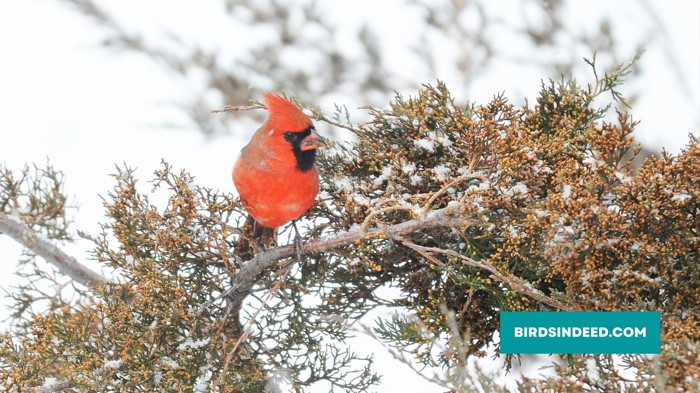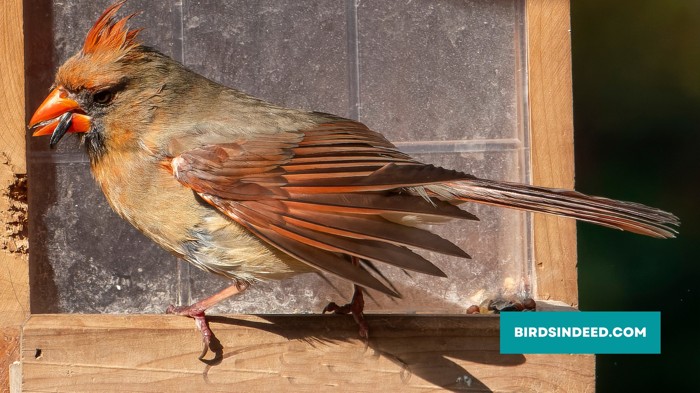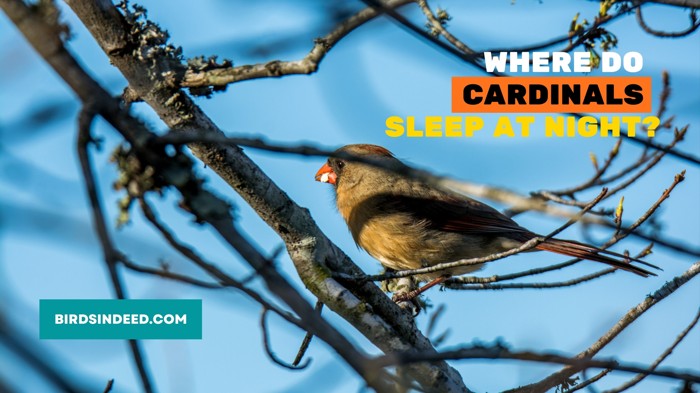Have you ever witnessed the captivating nighttime habits of cardinals? Or have you ever thought why you can’t see cardinals at night? That’s really interesting to think about because if you sneak in top of trees maybe it’s tough to see crows at night. Cardinals are those songbirds who do their nesting where they can remain hidden between tangled vines, branches, shrubs, dogwood, blackberry brambles etc. Cardinals always build their nest 10-15 feet off the ground and build their nest at low herbage.
If you’re curious about “where cardinals sleep at night”, the question to ponder is: Where do these colorful birds find their resting places? Northern Cardinals need to be in environments where they feel more secure.
Today we will also describe the nesting behavior of the cardinals. If you stay with us that can be more convincing for you so how you can save them from cats, and predators.

Contents
Where do cardinals commonly nest at night?
As we have discussed earlier, northern cardinals don’t stay on the ground so the question is “Where do cardinals sleep at night?”. Northern Cardinals typically roost at night in trees, shrubs, or other vegetation. They may also roost in man-made structures such as birdhouses or bird feeders. The choice of roosting site varies and can depend on factors such as the availability of shelter, the proximity to food sources, and the presence of predators.
In general, Northern Cardinals prefer to roost in thick vegetation, such as evergreen trees or dense shrubs, for protection from the elements and potential predators. However, their choice of roosting site may also depend on their daily routines, such as foraging for food, and may change from day to day.

What are the cardinals’ requirements to have a sound sleep?
You might have heard about the term roosting. Roosting is the behavior of birds where they gather and perch in a specific place to sleep or rest overnight. It provides protection, conserves energy and can be communal or solitary. Roosting is crucial for bird survival and health. Now we will list out what are the main requirements to fix a spot for their sound sleep.
| Safety | · Before spotting a nest their first priority is a safe place for sleeping. · They Choose high trees, dense shrubs, and open birdhouses. · They don’t choose the place near the ground and only spot the place where they can sleep well in every situation. |
| Disturbance | · Cardinals don’t want that no other cardinals don’t deserve them. · They want a secure and sound sleep. |
| Rapid Action | Northern Cardinals are smart ones! To keep themselves safe from predators, they choose a place to make their nest where predators rarely kick in. They choose a safe and tricky place from which they can suddenly fly away in multiple ways. They do it so that, whenever they think a deadly predator is around, they escape as soon as possible from the danger. |
| Observational Position | · Northern cardinals carefully position themselves in their nest, adjusting their viewing angle to keep a watchful eye on their surroundings. · A good angle can help them to prepare for any kind of danger. |
| Peace and quiet area | · The Sleeping sense of cardinals is the same as other common birds. · They choose the height of the tree so that they don’t feel disturbed. |
What do Cardinals do when a natural disaster occurs?
When faced with a natural disaster, such as severe storms or wildfires, cardinals, like other birds, exhibit certain behavioral adaptations to cope with the challenging circumstances. Here are some common responses observed in cardinals during such events:
- Seek Shelter: Cardinals have a natural instinct to find refuge and protection when faced with imminent danger. They may seek shelter in dense vegetation, trees, or bushes, utilizing their ability to maneuver through foliage to find a secure spot.
- Flight Response: If the disaster allows for sufficient time and space, cardinals may choose to fly away from the affected area to seek safer surroundings. Their strong flight capabilities enable them to cover considerable distances in search of a more suitable habitat.

- Temporary Displacement: In some cases, cardinals may temporarily relocate to neighboring areas unaffected by the disaster. This displacement is often temporary until the conditions improve, and they can return to their original habitat.
- Resilience and Adaptation: Cardinals have demonstrated resilience in recovering from natural disasters. They possess the ability to adapt to changes in their environment, including the loss of nesting sites or food sources. Over time, they can rebuild their populations and reestablish territories.
It’s important to note that the response of cardinals to natural disasters can vary depending on the specific circumstances and the severity of the event. Nonetheless, these adaptable birds employ their survival instincts and inherent behaviors to navigate through challenging situations and recover in the aftermath of such disruptions.
What steps should you take for cardinal safety?
To ensure cardinal safety, provide birdhouses or feeders, plant bird-friendly vegetation, avoid pesticides, reduce window strikes, and respect their habitat. Protecting their environment helps ensure their well-being. There are a number of features that you can apply.
To ensure northern cardinals’ safety, take these steps we’ve given below:

- Make windows visible to birds using decals, films, or screens.
- Keep domestic pets indoors or supervised and install predator guards on birdhouses and feeders.
- Provide shelter and cover by planting dense shrubs, bushes, and trees.
- Offer a varied diet of bird-friendly food without harmful pesticides.
- Clean and maintain feeders regularly, removing spoiled food promptly.
- Ensure access to fresh water by placing clean bird baths or shallow containers.
- Minimize disturbances around cardinal nests and nesting areas.
- Promote a safe habitat by reducing the use of harmful chemicals.
- Monitor and respond to local hazards promptly.
- Try to keep the light to minimum because light can make them disturb in their regular routine.
- And if you want to know how to build the house you can check our previous article “ Where do cardinals build their nest?“.
If you take these steps, it will help keep cardinals safe and create a secure habitat for them.
FREQUENTLY ASKED QUESTION
Do cardinals sleep in nests like other birds?
No, cardinals do not typically sleep in nests. They use nests primarily for breeding and raising their young. Instead, cardinals prefer to find sheltered spots such as dense vegetation, bushes, or trees to sleep at night.
Are cardinals nocturnal birds?
No, cardinals are diurnal birds, which means they are active during the day and sleep at night like most other birds. They are known for their vibrant appearance and melodious songs, often seen and heard during daylight hours.
How can I create a suitable sleeping habitat for cardinals in my yard?
To provide a comfortable sleeping habitat for cardinals, it's essential to offer dense vegetation, such as shrubs or trees, that can serve as protective cover. Planting evergreens or providing birdhouses can also give cardinals suitable options for nighttime rest.
THAT’S ALL, FOLKS!
When you think about why you can’t see the cardinals at night then you understand that they are always in a shelter so that they can save their females and babies from predators. If you can make an artificial house in your yard that can be best for them.
Keep in mind that cardinals are diurnal(being active during the day and sleeping at night) but anyhow if you find that the cardinals are screaming from your backyard that means the predators or maybe your pets are attacking them.
Kazi Rifat is the Editor & Author at Birds Indeed, a blog dedicated to all things avian. With a passion for birds and a background in Computer Science, Kazi brings a unique perspective to the world of bird watching and conservation. Follow along on his feathery adventures and learn something new every day.







